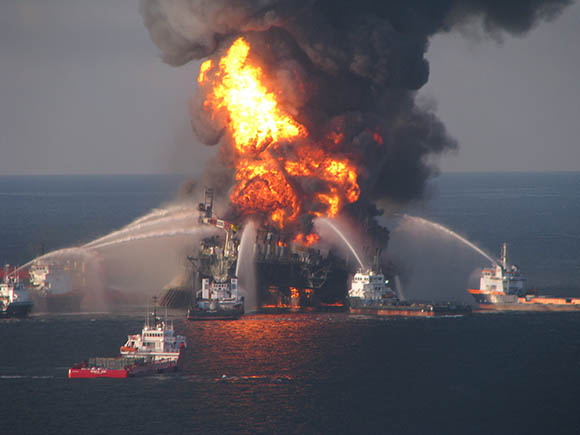Health Effects of Environmental Disasters
GuLF Study Assesses Exposure After Oil Spills

CREDIT: CHIEF PETTY OFFICER ROB SCHRADER, U.S. COAST GUARD
The U.S. Coast Guard fire response team battles a fire on the Deepwater Horizon offshore oil rig in 2010.
On April 20, 2010, the Deepwater Horizon offshore oil rig exploded, burned, and sank in the Gulf of Mexico, about 40 miles off the coast of Louisiana. Eleven of the 126 workers on board were killed in what is still considered one of world’s worst environmental disasters and the largest marine oil spill in United States history. The underwater well, almost a mile below the surface, spewed more than 200 million gallons of oil for the next 87 days before it was capped and sealed. Over the next year and a half, the many thousands of people who helped with the cleanup were exposed to toxicants related to crude oil, burning oil, dispersants, and other pollutants.
Researchers at the National Institute of Environmental Health Sciences (NIEHS) have been assessing the health effects of the oil spill ever since. In a recently released monograph, the scientists described the extraordinary work that went into developing inhalation and skin exposure estimates for people involved in the response and cleanup efforts (Ann Work Expo Health 66:Supplement 1, i3–i249, 2022). The report underpins 10 years of research generated from the Gulf Long-term Follow-up study (GuLF study).
Shortly after the Deepwater Horizon disaster, NIEHS launched the GuLF study to follow response workers over time and examine the health effects associated with environmental exposures during the cleanup effort. Participants living in states along the Gulf completed home exams that collected biological samples and clinical data. Two follow-up efforts have been completed. Health histories were updated by telephone interviews and clinical exams; clinical data—including measures of lung and neurological function—were collected for a subset of the cohort. The study is the largest ever conducted on the potential health effects associated with an oil spill; it has enrolled about 33,000 participants and produced more than 40 publications.
Papers resulting from the GuLF study have reported that workers who participated in the cleanup effort experienced mental health problems, such as post-traumatic stress disorder and depression; decreased lung function; heart disease; and a range of symptoms consistent with the effects of neurological and respiratory diseases. Workers also experienced increased risk of developing high blood pressure (JAMA Netw Open 5:e220108, 2022) and were 60% more likely to be diagnosed with asthma than those who did not work on the cleanup (Environ Int 167:107433, 2022).

CREDIT: STEVE MCCAW, NIEHS
NIEHS Senior Investigator Dale Sandler is leading the GuLF study, which is assessing the long-term health effects of the 2010 Deep Water Horizon oil spill.
In the monograph, scientists described how the statistical and methodological underpinnings of the exposure estimates were developed. They highlighted approaches for dealing with large amounts of missing data, sources of data used to generate estimates, and theoretical models that were developed to describe exposures that could not be directly measured. Reports include exposure levels of six components of crude oil and fine particulate matter produced by the burning and flaring of oil and natural gas.
“No oil spill study has ever undertaken an exposure-assessment project as extensive as ours,” said Senior Investigator Dale Sandler, who is chief of the NIEHS Epidemiology Branch and leads the study. “This [project] is a monumental accomplishment by our exposure-assessment team.”
Workers exposed
The researchers found that workers on all vessels associated with the oil rig, fire control, research, and other water operations had exposure to the compound benzene—a known carcinogen.
“With information on which job roles may be most vulnerable, those responsible for oil-spill cleanup work can better plan how to protect workers from similar exposure scenarios,” said Kaitlyn Lawrence, a staff scientist in the NIEHS Chronic Disease Epidemiology Group. She began working on the GuLF study in 2014 as a summer intern, and under the mentorship of Sandler. Lawrence used GuLF study data in completing her doctoral dissertation on the impact of oil-spill exposures on lung function.
Measuring exposures to disappearing substances

CREDIT: STEVE MCCAW, NIEHS
NIEHS Staff Scientist Kaitlyn Lawrence, who began working on the GuLF study in 2014 as a summer intern, used the study’s data in completing her doctoral dissertation on the impact of oil-spill exposures on lung function.
The research team first created exposure groups, defined as workers performing similar tasks who likely had comparable exposures. Those groupings were based on information about both inhalation of and skin contact with oil components over varying time windows during the cleanup effort. Assessments took place over a broad geographic area in the Gulf of Mexico and along the coast of five Gulf of Mexico states. Workers’ exposures varied with weather and location, and over time.
“The [oil-cleanup site] exposures on one day were not the exposures on another due to weathering of the oil, which changes the levels of volatile chemicals over time,” said Sandler. Health effects also depended on responders’ job tasks and the length of time worked.
Novel statistical methods were developed to assign exposure levels to all workers participating in the GuLF study. According to Sandler, the scientists combined air exposure measurements taken at the time of the spill, the team’s modeling of exposures not measured at the time of the spill or afterward, and individuals’ descriptions of their cleanup-related jobs.
Oil spills around the world
With a continuing need for oil-cleanup operations around the globe as accidents occur, many people may be exposed to toxic substances in cleanup efforts. Data from the U.S. National Oceanic and Atmospheric Administration Office of Response and Restoration show that the office responded to 139 incidents in the first 10.5 months of 2021. Of those cases, 108 involved oil.
“One would be hard-pressed to find this level of detailed exposure assessment following occupationally related disaster exposures of any type,” said Lawrence. “This monograph should be looked to as a model for any future similar industrial hygiene effort.”
The exposure methods and findings are now accessible to researchers and policymakers in the journal Annals of Work Exposures and Health (Ann Work Expo Health 66:Supplement 1, i3–i249, 2022).
More information can be found on the Gulf Study website: https://GuLF study.nih.gov/en/index.html

Catherine Arnold is a writer for the National Institute of Environmental Health Sciences Office of Communications and Public Liaison. In her spare time, she enjoys walking/biking in neighborhoods, drawing and illustration, and spending time with her partner and friends.
This page was last updated on Monday, September 19, 2022
